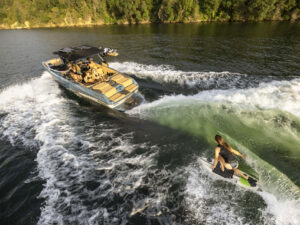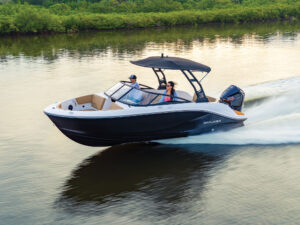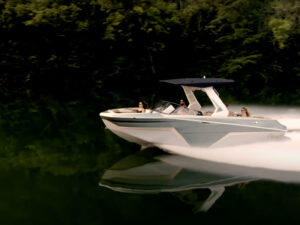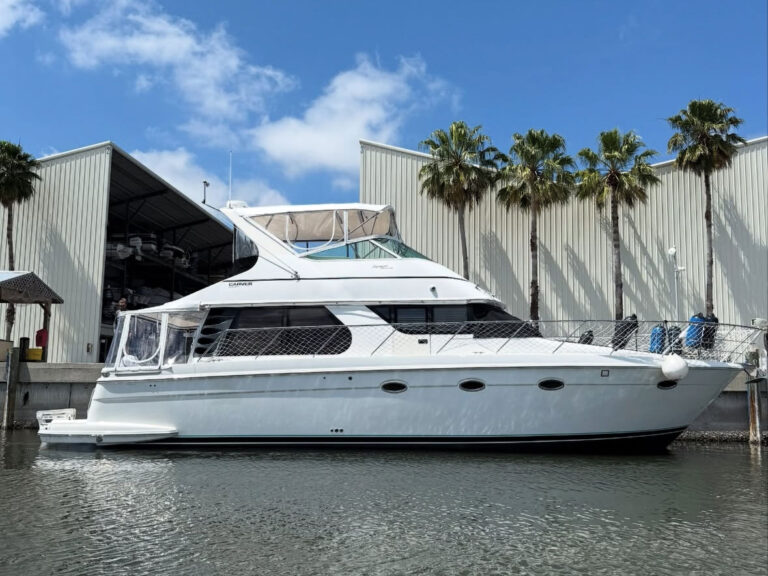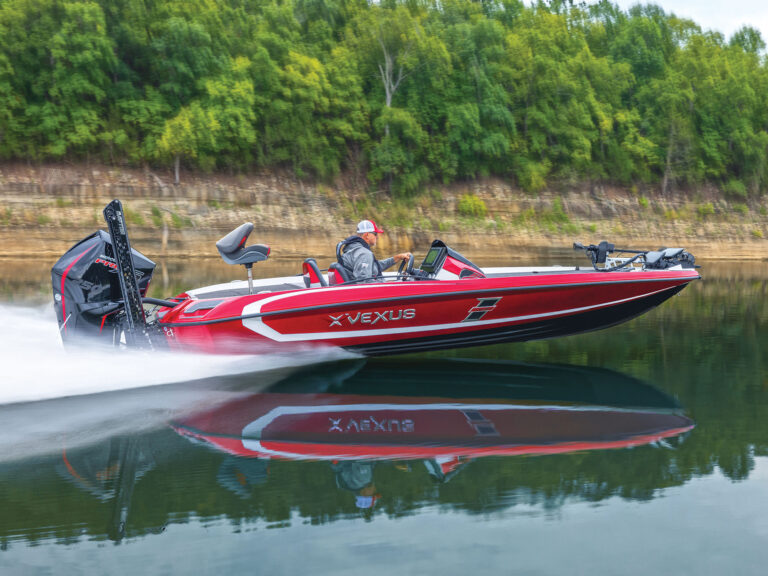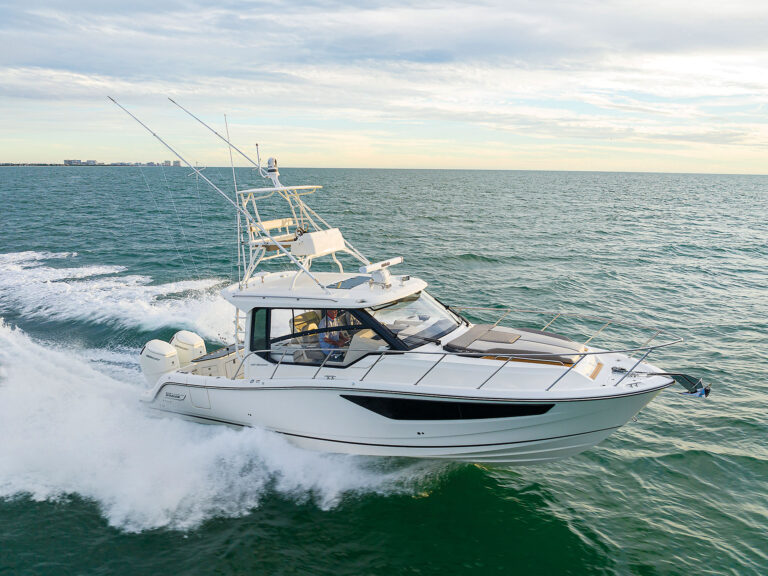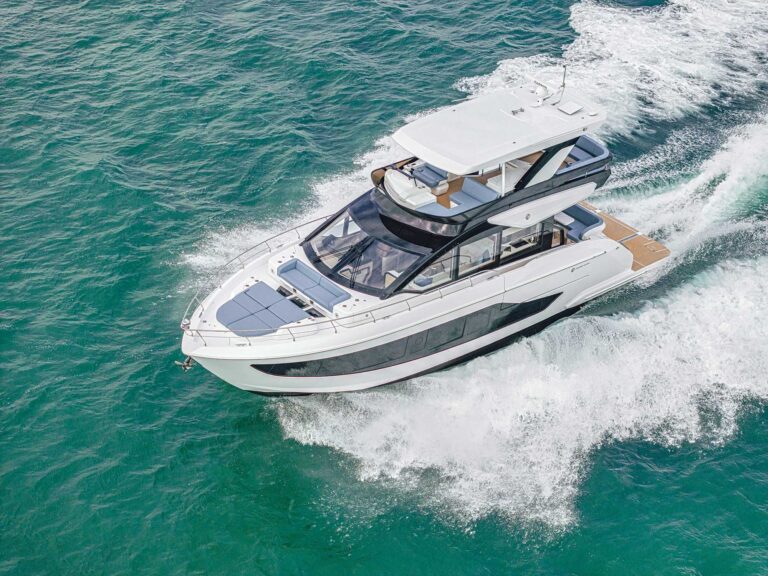
With my feet planted on a surfboard and gliding on a perfect wave behind a loaded MasterCraft XStar, I had one goal in mind: to let go of the rope. It went against everything I’d learned about tow sports over the years of waterskiing, wakeboarding and wakeskating. The rope has been an essential part of the equation. But here, today, to do this right, I had to let go and let the boat’s massive wake do the work. Thankfully, I had Travis Moye calling out to me from the back of the boat, teaching me how.

Getting Started
The Boarding School sits on an 88-acre plot of land with three interconnected private lakes, about a half-hour drive from the Orlando International Airport. Turning onto the road into the property, I passed by a farm that had an ostrich in its front paddock, staring at me as I passed by. I parked in front of the ranch house and walked to the docks in the back, where a woman sat at a table with her young son, who was playing with Transformers. Both the ski boat and the wakeboat were gone from their slips, but in the distance, we could see the tops of large rooster tails being sprayed — the unmistakable calling card of a slalom skier.
“That’s my husband,” the woman explained. “The only way we can get him to go to Disney is if he can spend a few days here too.”
After a few minutes, the rooster tails stopped cresting over the tops of the bushes, and we could see the two MasterCraft boats headed to the docks — a Pro-Star, a quintessential ski boat designed to minimize wakes, and the XStar, a boat designed to up the wake amplitude.

A fit 45-year-old man in boardshorts stepped to the dock, his long hair hidden under a trucker’s cap and held behind his head in a ponytail. “Welcome,” he said. “I’m Travis Moye.” As a teenager, Moye cut his teeth in water skiing, winning the national championship several times over. After graduating from the University of Alabama, he transitioned to wakeboarding, eventually becoming one of the most precise boat drivers in the world, knowing how to produce wakes for the exacting demands of professional boarders. When surfing surged in popularity, he knew how to create the perfect wave too. He also owns the Boarding School.

Just as the Disney family was leaving the dock after Dad’s slalom session, a young wakeboarder from Israel emerged from the house, which has overnight accommodations, to begin his morning session.
“All kinds of people come here,” Moye said. “From the slalom-skiing moms and dads looking to get back into it, to kids looking to learn to wakeboard for the first time, to tournament riders looking to train.”

For decades, wakeboarding has reigned supreme as the “cool” watersport of choice among the younger crowd. But with its aerial acrobatics, wakeboarding can be really hard on your body, and Moye noted that as the ’boarding crowd grows older, many of them are reverting to slalom skiing or, like me, taking up surfing.
For my session, Moye grabbed fellow instructor Jimmy McClure to drive the boat so he could concentrate on getting me up to drop that rope. We idled out past the skate park — yeah, you can wakeskate behind a cable here too — and I jumped off the swim platform ready to ride that wave. But first, I had to get up.
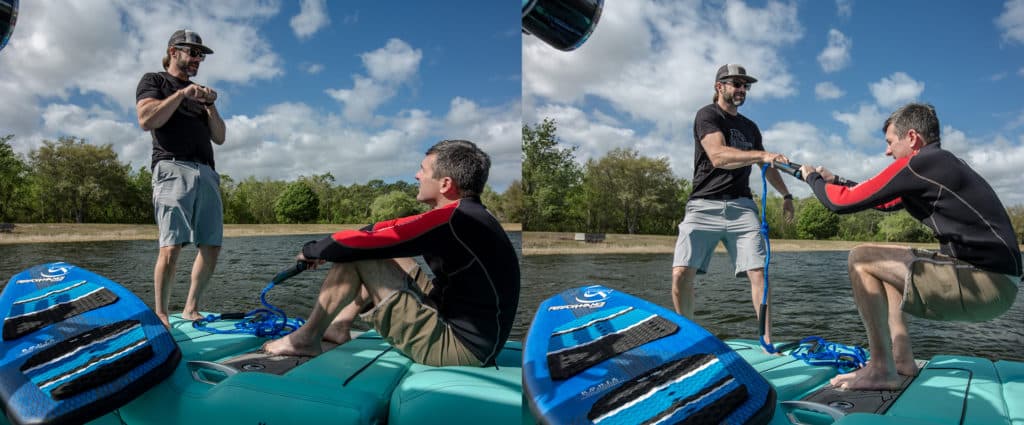
Getting Roped In
As I swam to get in position behind the XStar, the first thing I noticed was how close I was to the back of the boat. While ski ropes are typically 75 feet in length, and wakeboarding ropes range from 65 to 75 feet, a surf rope is between 10 and 25 feet at most. It’s really just a tool for getting up.
Moye started me on a more buoyant board designed to provide more stability for beginners. To start, I floated the board in front of me and placed my heels on top of the board about shoulder width apart. Moye instructed me to dig my heels in to apply pressure so that the board now sat vertically in the water rather than floating on top. I floated behind the boat with my knees bent and my arms straight in front of me, holding the handle. If you’ve ever wakeboarded, the start is very similar, but for water-skiers it is counterintuitive. Rather than pulling back against the rope, you let the boat do the work. As it pulls you forward, the board will pop onto plane underneath your feet and you simply stand up. Once you get to your feet, you need to quickly move outside the wake and get ready to ride it.


After a false start or two, I found myself staring at the large clean wave that formed just off the XStar’s swim platform. Wanting to get right to it, I pulled hard on the rope handle and accelerated into the face of the wave, shooting right past the sweet spot and almost into the transom. I tried to slow myself down and whipped backward off the back of the wake. I tried to drop back in and buried the nose of the board. Fortunately, since the boat is only moving along at about 10 mph, a wakesurfing wipeout doesn’t hurt.
“That’s the biggest mistake people make,” shouted Moye after the boat circled back to me. “Using the rope to pull themselves into the wave.”



Moye instructed me to shift my balance so that I was leaning more forward over the board and to use heel-to-toe motions to control the board.
“Think of your front foot as the gas pedal and your back foot as the brake,” Moye said.
Once up again, Moye coached me to apply pressure to the front of the board with my toes on my forward foot as I moved into the wave. As I got comfortable doing that, I noticed my weight naturally shifting forward, and I could feel the board catch in the wave. I worked my way into the sweet stretch of water behind the transom and felt the rope start to slack in my hand. This is it, I thought to myself, and threw the rope toward the swim platform. Within seconds, I found myself sucked back over the top of the wave, and the next thing I knew, I was floating again, waiting for McClure to circle the XStar back to me.

Letting Go
As I lined up again behind the boat, Moye offered more words of wisdom.
“You were trying to cut too much side to side like you were skateboarding,” Moye said. “You don’t have to move your feet that much. Just be really subtle and focus on turning into the wake, not away from it.”
Moye instructed me not to focus on dropping the rope, but on working to stay in the sweet spot within the wave. I spent the next few runs in the session holding the rope handle casually off my front hip, never letting go, even as the rope slacked off. Moye focused solely on my footwork, helping me reposition my forward foot closer to the inside rail of the board so I could exert better control. He had me work on constantly staying connected to the wave rather than trying to cut out of it and back in — which is counterintuitive to both skiing and wakeboarding, where you cut far outside the wake to generate leverage before you cut back into it.




“Once you get the rhythm of it, surfing’s pretty basic,” Moye said. “You can do it all day long.”
Moye and McClure had other students to attend to — the boarder from Israel was due for another session — so I didn’t have all day. On the next pass, I worked my way into position, knees slightly bent with my weight forward, and felt the rope go slack as I propelled the board down the face of the wave. Again, I dropped the rope. Only this time, I stayed connected to the wave. A feeling of complete liberation came over me as I looked up. There I was, surfing a beautiful wave behind the XStar.
“Yeeaaaaaaah!” Moye shouted, and I could see the smile on his face. It turns out, you can teach an old dog new tricks. You just have to send him back to school.

The Wakeboat
As a tournament-level tow-boat driver, Travis Moye has been working with MasterCraft for decades and knows exactly what he wants in his tow boats. Here’s a list of features he likes aboard the XStar to help throw a clean wake.
MasterCraft’s Gen2 Surf System
This includes shaping devices, which are essentially tabs on the transom you deploy to shape the wake.
Ballast
The XStar has an easy-fill ballast that can add 2,995 pounds to help shape the wake (1,097 pounds to either ballast tank on the transom and 800 pounds in the centerline ballast tank forward).
Murphy Touchscreen
The driver can set the speed, ballast and tabs to create a wake tailored to each rider’s preferences at the push of a button.


